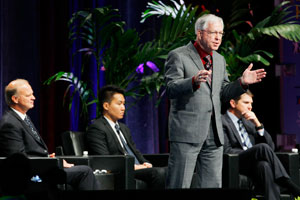TMC Panel Says Importance of Telematics to Trucking Will Accelerate

“The convergence of a truck, a computer and communications,” telematics is “the one common factor” in all discussions of how trucks will operate in the future, panelists said at the Oct. 20 event sponsored by the Technology & Maintenance Council of American Trucking Associations.
Carl Kirk, TMC’s executive director and the panel’s moderator, said his group wants truck makers to agree on the same basic starting point, or data bus, for telematics equipment so technicians will have a common frame of reference.
Brian McLaughlin, president of in-cab communications and software firm PeopleNet Communications, said telematics could soon become universal in U.S. heavy-duty trucks because of the federal regulation coming on electronic logging devices.
Many carriers take a full-service approach, McLaughlin said, where the in-cab communications units perform functions such as fuel-tax reporting, navigation and trailer and engine monitoring, in addition to logging of driver hours.
The other approach McLaughlin called a point solution, where a driver would get the minimum system necessary to comply with the hours logging rule once it is published by the Federal Motor Carrier Safety Administration.
Two competing options that have been gaining in popularity recently are COPE and BYOD.
A Corporately Owned, Personally Enabled system is supplied by the company but customized by the driver and is seen as a comfort to offer drivers.
The Bring Your Own Device approach works well for owner-operators, McLauglin said, allowing a driver with a smartphone to hook up with the motor carrier’s system.
Paul Menig, CEO of consulting firm Tech-I-M, said telematics generates data from each truck where it is used. He would like to see it aggregated among large numbers of fleets and used by manufacturers to design better trucks and improve maintenance procedures.
Analyst Wallace Lau of Frost & Sullivan in Toronto documented how average engine size for heavy-duty trucks has been declining in North America and elsewhere.
F&S expects that in 2018 the typical engine size will be 13.4 to 13.7 liters, down from 13.7 to 14.1 liters in 2012, a decline of 3%. He said the trend toward regional hauling, away from longhaul trucking, is largely responsible.



